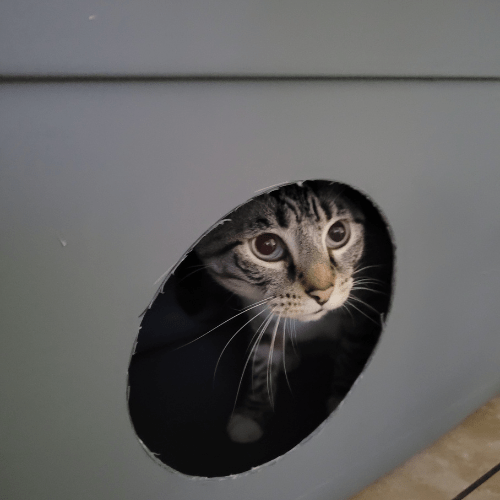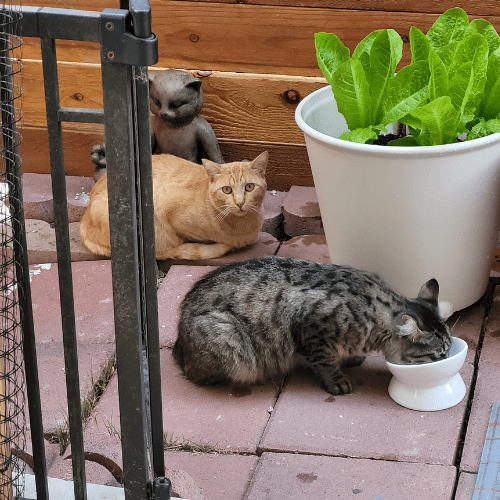
How to care for an outdoor cat
Indoor life is the best thing for most cats. However, sometimes the best option is to keep a cat outdoors—such as with an older feral cat.
Outdoor cats should be brought inside when at all possible. When this can’t happen, you can still make an outdoor cat’s life better by providing them with food, shelter, and medical care. Daily attention can go a long way toward lengthening a cat’s life and keeping them safe.
Taking care of an outdoor cat is an entirely different experience compared to caring for an indoor one. As an outdoor cat owner, you are tasked with providing for its needs while also allowing it the freedom to explore the great outdoors. This balance can be a challenge, but with the right knowledge and preparation, it can be achieved.
Whether you’re a seasoned cat owner or a beginner, the tips from experienced outdoor cat owners will provide useful insights to help you navigate the journey of caring for an outdoor cat.
How long do outdoor cats live?
The average lifespan of cats can vary greatly depending on whether they live indoors or outdoors. Indoor cats typically live significantly longer, with an average lifespan of 12 to 18 years. This longevity can be attributed to the controlled environment, regular feeding, and minimal exposure to dangers like traffic, predators, diseases, and harsh weather conditions.
Outdoor cats, on the other hand, face a different reality. Given the numerous risks and challenges they face daily, outdoor cat’s average lifespan tends to be much shorter, estimated at 2 to 5 years. However, this doesn’t mean an outdoor cat cannot live a long, fulfilling life. With proper care, regular veterinary check-ups, and suitable safety measures, an outdoor cat’s lifespan can be significantly increased.
What do outdoor cats do all day?
Outdoor cats live different lives than indoor cats. They tend to wander, sometimes up to 1,300 acres away from home, they hunt, and they have to avoid predators (source).
You might notice your outdoor cat leaving for days at a time, then coming back for dinner one night as though nothing happened!
It’s a common myth that cats are nocturnal. They’re actually crepuscular. They sleep 15 hours a day on average and are most active at dawn and dusk (source).
During the day, they can be found chasing insects, exploring new areas of their territory, hunting for prey, or lounging in the sun. They also may spend time playing with other cats in their area or simply taking naps in shaded locations.

The best bedding for outdoor cats
You want bedding that fits the weather conditions and may need to change the bedding often. Straw is always a good option, no matter the climate.
In warm climates, opt for a cool and comfortable bedding material like straw, blankets, or cat pads You’ll still need to keep them clean, but this type of bedding is excellent at keeping the cat cool in the summer months.
If you live in cooler climates, then stray bedding works best as it provides insulation against cold weather throughout the year. Also, keep in mind that cats prefer soft and fluffy bedding, so be sure to invest in quality materials for your cat shelter!
Natural cat litter for outdoor cats
Natural cat litter is made from natural ingredients like wood, wheat, or corn, so they are biodegradable and don’t contain harsh chemicals that can be harmful to cats.
Aside from being better for the environment, using natural cat litter for outdoor cats can be beneficial in a few ways. They won’t turn into a muddy mess when it rains, and they’ll be easier to clean on a frequent basis.
What do outdoor cats eat
A common misconception is that cats are good at feeding themselves outdoors. Even feral cats rely heavily on humans and will dig through trash to find food.
Cats are natural hunters, so you can also supplement their diet with raw small game like mice or bunnies. They also hunt lizards, rats, and birds, but this likely won’t be enough to sustain your cat. Sometimes, wildlife animals can contain parasites, diseases, and poisons that are dangerous to your cat, so you shouldn’t encourage them to eat them.
Wet food is better for cats than kibble because it’s less processed. It also contains more moisture, which is vital for cats’ kidneys. Their bodies are built to obtain most of their water from their prey, not by drinking.
I prefer grain-free food for all our cats.
I also like to add water to my cat’s food. It’s especially important to hydrate kibble before feeding it to your cat so that they get that added water in their system.
A balanced diet is essential for any cat, regardless of whether they are indoor or outdoor. Not only will feeding them high-quality food help keep your cat healthy, but it will also encourage them to stay closer to home.
How to care for outdoor cats in the winter
Winter can be a difficult time for all cats, especially outdoor cats. While their fur helps keep them warm in the cold weather, they are still vulnerable to frostbite and hypothermia. As an outdoor cat owner, it’s important to take extra measures to protect your pet during the winter months.
First and foremost, make sure your cat has access to cat shelters and plenty of bedding. It’s also important to provide your cat with a heat source like a heating blanket or heated water bowl and nutrient-rich food to help keep their caloric intake higher.
Finally, make sure you check on your feline friend regularly during winter months to ensure that they are healthy and safe. Make sure their mood and alertness are normal, which can be signs of health concerns.

How cold can cats survive outside?
Cats can survive in cold temperatures, but they are still at risk of frostbite and hypothermia. In general, cats should not be exposed to temperatures below 40 degrees Fahrenheit for extended periods of time. The exact temperature will vary depending on the cat’s size, coat thickness, and overall health condition.
In snowy climates, it’s important to make sure your cat has help keeping them warm, fed, and safe during winter. This includes providing an outdoor cat shelter, heated water bowls, and quality bedding materials that provide insulation against cold temperatures.
It will be more difficult for your cat to find food, so make sure to provide them with extra cat food to keep their body weight up during the colder months.
How to keep my outdoor cat’s water from freezing
To prevent your outdoor cat’s water from freezing in cold temperatures, you can use heated water dishes or bowls. These are electric-powered water bowls that keep the water warm and free of ice all through the winter months.
If you don’t have access to a heated bowl, you can add warm water to the bowl each time you replace it, though this should be done with caution as cats don’t like sudden temperature changes.
Elevating and insulating the water dish will also help retain the heat of warm water longer.
How to care for outdoor cats in summer
In the summer months, it’s important to make sure your outdoor cat has shade, shelter, and plenty of fresh water. Provide plenty of covered areas for them to rest in, and make sure you add cold water daily. You can also give them wet food with cold water to help keep their body temperature down during hot days.
Cats are vulnerable to heatstroke and can suffer from dehydration in extreme temperatures, so it’s important to keep an eye on them when they’re outside. Additionally, always make sure you have a plan for getting your cat inside if it becomes too hot or starts showing signs of distress.
Know the signs of heat exhaustion and be prepared to act quickly in case of an emergency.
What outdoor temperature is too hot for cats?
Cats have a higher body temperature than humans, so they can easily overheat if they are exposed to extreme temperatures. In general, cats should not be exposed to temperatures above 90 degrees Fahrenheit for extended periods of time as this could lead to heatstroke or other health problems.
How to feed outdoor cats without getting ants
Ants can be such a hassle! Cats and ants often attract each other, so it can be difficult to feed your cat outside without drawing an unwanted crowd. To help prevent this, make sure you are using airtight containers for food storage and don’t leave any food out in the open.
Additionally, sprinkle some diatomaceous earth around the perimeter of the feeding area to deter ants from coming close.
Placing the cat’s food dish inside another bowl to create a water moat is also a solid strategy. Fill the bowl with water and place a smaller/tall food dish inside so the ants can’t get to it. Ants can’t swim!
Finally, clean up any spilled food regularly, and don’t leave leftovers out in the open overnight. Taking these precautions should help keep ants away and ensure your outdoor cat gets the nutrition they need.
What diseases can outdoor cats get?
Cats that spend most of their time outdoors are at increased risk of exposure to parasites and diseases than indoor cats. Some common illnesses outdoor cats can get include fleas, ticks, mites, feline immunodeficiency virus (FIV) or feline aids, Feline leukemia virus (FeLV), ringworm, upper respiratory infections, and more.
Make sure to regularly inspect your outdoor cats for fleas or other parasites. In addition to regular check-ups, preventive grooming, and parasite control are essential for keeping outdoor cats safe and healthy.
It’s important for cat’s health to keep up with regular check-ups and vaccinations to make sure they’re healthy and protected. Additionally, always be on the lookout for signs of illness or distress in your cat and bring them to the vet as soon as possible if you notice anything abnormal.
What vaccinations do outdoor cats need?
Outdoor cats should receive the same vaccinations as indoor cats, plus some additional ones. Vaccinations for kittens can begin around 2 months old. However, we prefer to allow the kitten to mature a few more months when possible. Vaccinations that outdoor cats should get include chlamydia, calicivirus (FCV), rhinotracheitis, panleukopenia (Feline Distemper), feline leukemia, and rabies.
These vaccines will help protect your cat from diseases they may be exposed to while outdoors and will also make sure they are up to date with their vaccinations.
Talk to your vet about the best vaccination plan for your cat, and make sure to schedule regular check-ups for them as well.
How often should outdoor cats be dewormed?
Outdoor cats should be dewormed at least every 4-6 months as they are more likely to come into contact with parasites. Your vet can recommend a deworming schedule and will also check your cat for any signs of infection or infestation during regular check-ups.
You can find deworming medicine online, which comes in a variety of options, including a one-time pill.
How often should outdoor cats have flea treatment?
There are many good quality flea treatments available that can help to get rid of any parasites on your cat. Most of them require a reapplication every 30 days, so you’ll need to plan a regiment. Many flea medications require a veterinarian prescription, so be sure to ask your veterinarian for advice on which one is best for your cat.
For feral or stray cat use, there are chewables and pills that can help give your outdoor cats some immediate relief from fleas. Capaction flea pills begin working in 30 minutes, and you can also supplement your outdoor flea prevention regimen with a chewable immune-boosting treat for your cats, specifically designed for fleas and ticks.
Click here for a few additional ways to prevent fleas on outdoor cats.
Keeping your outdoor cat safe
Some people wrongly claim that there are no risks to allowing their cats outdoors. They think their environment lacks predators and that their cat is smart enough to make sound decisions, like not walking into traffic.
This couldn’t be less true. No matter where you live, letting your cat outdoors is a risk—and it’s a risk you need to understand before making such a life-changing decision for your pet.
Make sure you give your cat a collar (with a breakaway mechanism) with identification tags and a microchip if they roam free. Be sure your safety collar and cat microchip have your current contact details for quick identification.

Lastly, try to bring them inside or into an outdoor enclosure at night to keep them safe from nocturnal predators like coyotes.
Keeping outdoor cats safe from predators
The biggest danger that outdoor cats face is predators such as coyotes, hawks, foxes, dogs, and other animals.
To keep your cat safe from these potential threats, make sure they have access to a secure shelter or hiding spot in the home and bring them inside at night if possible.
Depending on the predators in your area, you can install fencing, bushes, or other deterrents to prevent them from entering your cat’s space.
You can also consider installing motion sensor lights around the perimeter of your yard, which will help scare away any predators lurking.
How to care for outdoor cats during a storm
If you can’t bring your outdoor cat inside during a storm, it’s crucial to ensure they have access to a safe and secure shelter. This could be a sturdy cat house or an adapted shed with enough insulation to keep them warm and dry.
Make sure the shelter is elevated off the ground to keep it from flooding and has an easy escape route in case of danger. Inside the shelter, provide a warm bed and fresh water for your cat. Remember, it’s always best to try and bring your cat inside if possible, but if that’s not an option, providing a safe and warm shelter is the next best thing.
How to stop outdoor cats from fighting
Outdoor cats are more likely to fight with other cats as they are competing for territory and food. To stop outdoor cats from fighting, it’s important to provide plenty of resources, such as food and water bowls around the home, so there is enough for everyone. Additionally, you can try placing a few cat beds in different areas to give them their own space.
You can also consider installing a cat fence to keep other cats from coming onto your property. This will help make sure that the cats in your home have enough resources and won’t be disturbed by any intruders. However, if you do find that two of your cats are fighting, it’s best to separate them immediately and talk to your vet about any potential medical issues or behavioral problems.



